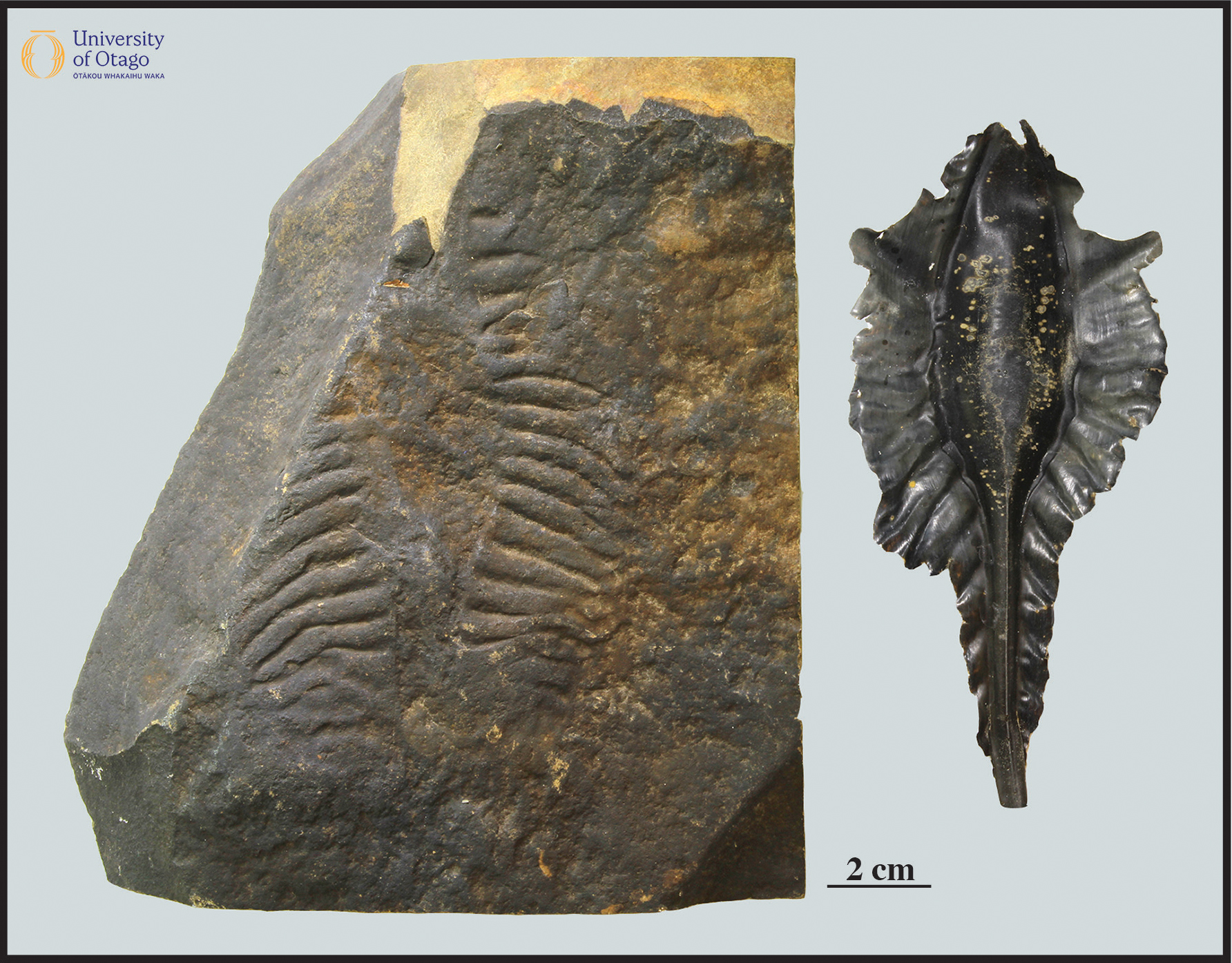4 Ghostly trace of an egg capsule
Chondrichthyes, Chimaeriformes: Chimaerotheca reperepe
Most of the fossils we are familiar with are the sturdier parts of ancient organisms such as shells, bones, teeth and wood. These mineralised or lignified parts are more likely to resist decomposition, and also stand a better chance of remaining intact during burial, uplift and the subsequent exposure to weathering. Fossils that form from the soft, unmineralised parts of animals are very rare by comparison. However, when traces of soft tissues are discovered they can provide insights into the biology and ecology of ancient life beyond what it is possible to learn from bones and teeth alone.
|
The left image shows a fossilised impression of an egg case, Chimaerotheca reperepe (specimen OU 22689). This trace fossil shows where an egg case from a chimeroid once lay against the sediment of an ancient sea floor. The right image shows an egg case from a living species of chimeroid. Image credit: JH Robinson. |
In 2014 an impression of an egg capsule from a close relative of a shark was reported from Late Triassic rocks in Southland. The Triassic was the earliest period in the Mesozoic era, which is more commonly known as the age of the dinosaurs, and relatively few fossils from vertebrates have ever been reported from rocks as old as these in New Zealand. Moreover, at the time of discovery this fossil represented the earliest evidence of cartilaginous fish (chimaeras, sharks and rays) in the fossil record of New Zealand.
 |
Did you know there is a 3D printable model of this fossil for you to view online and download? Follow this link to learn more: 3D model—Ghostly trace of an egg capsule. |
The egg capsule fossil is from a chimeroid chondrichthyan. Chimeroids are animals within the group Chimaeroidei which includes the reperepe or elephant fish/ Australian ghostshark (Callorhinchus milii). Reperepe live in the waters around southern Australia, Tasmania and northern Aotearoa today. Chondrichthyans are fish which have skeletons mostly made from unmineralised cartilage. Like many of their shark relatives, chimeroids reproduce by laying eggs that are protected by a toughened egg capsule constructed from collagen. Chimeroid egg capsules have distinctive shapes, and the Triassic fossil from Southland has a similar shape and size to the egg capsule produced by living reperepe. The similarity in shape tells us that the basic mode of reproduction for chimeroid chondricthyans has remained essentially the same for the last 200 million years.
The fossil is the result of the egg capsule becoming buried in silt and very fine sandstone. The sediment was pressed in close against the outer surface of the egg capsule and became cemented. Over time the collagen and other biological material in the egg capsule decomposed, leaving behind a trace fossil impression. This trace fossil of the chimeroid egg capsule was named Chimaerotheca reperepe.
During the time that the animal which made the egg capsule was alive Zealandia was still part of the giant southern landmass Gondwana. The discovery of Chimaerotheca reperepe extended the fossil for chimeroids living in the ancient southern ocean alongside Gondwana by more than 100 million years. The discovery also revealed that chimeroid chondricthyans were living at high southern latitudes during the Late Triassic given that Zealandia has drifted northwards in the time since the egg capsule was made.
—Written by Daniel B Thomas
| Specimen number: OU 22689 | Age: Approximately 208 million years old (late Triassic, Warepan or Otapirian stage) |
| Locality: Taringatura Hills, Southland | Rock Formation: Murihiku Terrane (formation not identified in publication) |
| Collected by: G Asher | |
| Citation: Gottfried MD, Fordyce RE. 2015. A Late Triassic chimaeroid egg capsule from New Zealand: early evidence of chimaeroid reproductive mode from the eastern margin of Gondwana. Journal of Systematic Paleontology 13:371–375. doi.org/10.1080/14772019.2014.880752 | |
Evidence of life from a past geological age. Remains like bones, shells or wood, or an impression like a footprint, or some other evidence of life, from something that was alive more than 11,700 years ago.
Connective tissues with a high proportion of accumulated minerals, generally a calcium phosphate mineral (bone) or a calcium carbonate mineral (shell). Mineralised tissues including bones and teeth are harder and more durable than cartilage-only skeletal tissues.
Plant tissues have have become rigid due to the accumulation of the organic polymer lignin. Wood is an example of a lignified tissue.
The process by which organic structures like animal bodies or tree trunks are broken down into simpler organic matter.
237.0 to 201.4 million years ago. The Late Triassic is the final epoch of the Triassic Period.
251.9 to 66 million years ago. The Mesozoic Era is the section of geological history spanning the Triassic, Jurassic and Cretaceous periods.
Animals that have bony tissues (e.g. vertebrae, teeth) and are quadroblastic (i.e. four germ-layers: endoderm, mesoderm, ectoderm and neural crest tissue).
Firm, flexible connective tissue found. One of two major components in the skeleton of all vertebrates (with the other being a calcium phosphate mineral).
A protein that is important for the structure of connective tissues. A key component of cartilage.
Evidence of an organism from a past geological age but not the preserved remains of the organism itself.
The mostly submerged continent of which New Zealand and New Caledonia are a part.
An ancient landmass that existed from the late Precambrian to the Jurassic, which upon fragmenting gave rise to Africa, Antarctica, Australia, India, Madagascar, South America, and Zealandia.


